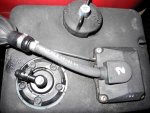I've never heard of such an installation... BUT... by any chance, is the oil tank installed higher than the engine?
Also... if the "Anti Siphon" valve at the fuel tank (the fitting that the fuel hose connects to) is stuck open, is not present, or has had the inner workings discarded (reducing it to a plain clear fitting, that would allow the fuel at the engine drain back into the fuel tank. How oil might fill those empty fuel lines is a unknown to me at the moment... BUT...if it were me, I'd inspect that valve.
********************
(Fuel Anti Siphon Valve)
(J. Reeves)
Many of the later OMC V/6 engines incorporate a fuel restriction warning via a vacuum device attached to the powerhead. If the engine overheats, or if you have a fuel restriction, the warning is the same.... a steady constant beep.
NOTE... Only the V/6 & V/8 engines have the above "Fuel Restriction Warning". The warning horn will not sound on the other models.
The fact that a engine is not overheating, but the warning horn sounds off with a constant steady beep, and that the rpms drop drastically would indicate that the engine is starving for fuel due to a fuel restriction. Check the built in fuel tank where the rubber fuel line attaches to the tank fitting. That fitting is in all probability a "Anti Siphon" valve which is notorious for sticking in a semi closed position. It will be aluminum, about 2" long, and the insides of it will consist of a spring, a ball, and a ball seat. If this valve exists, remove it, knock out those inner components which will convert it to a straight through fitting, then re-install it. Hopefully that cures the problem.
The above procedure will cure a restriction problem with the anti siphon valve as stated. BUT, it may also allow fuel to drain backwards to the fuel tank when the engine is not running (siphoning backwards) due to the fact that the carburetors/fuel pump etc are higher than the fuel tank. This condition is not an absolute as the valves in the fuel primer bulb usually prevent this backwards siphoning problem. However.... if this does take place, the cure would be to install a new anti siphon valve.
NOTE: There has been cases when the output valve in the fuel primer bulb would come apart, and the inner portion of the valve would actually reverse itself and be drawn back into the primer bulb's output valve body. This in effect would create a shut off valve and result in a fuel restriction. If this is the case, you should be able to feel something laying in the bottom of the primer bulb when held horizontally.




















